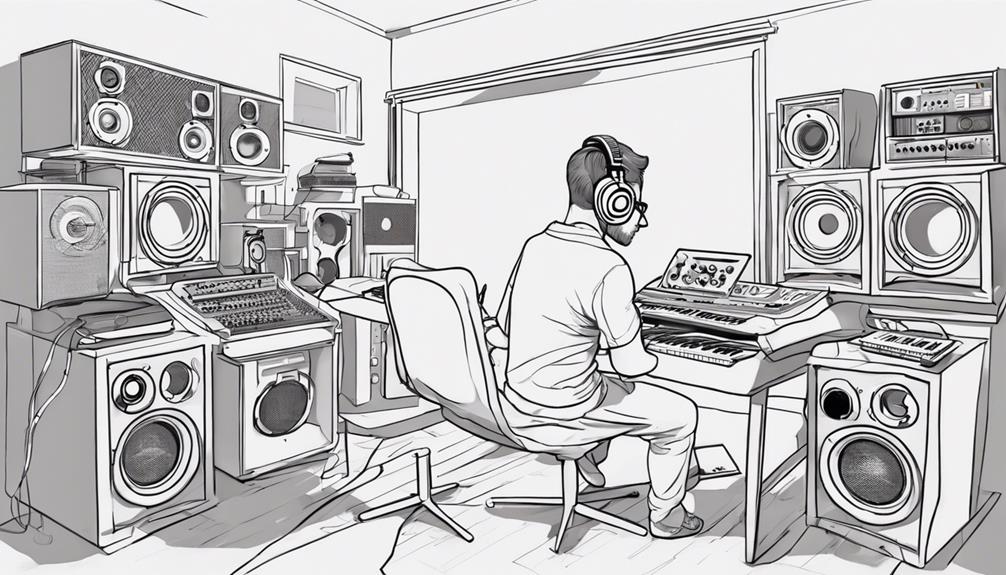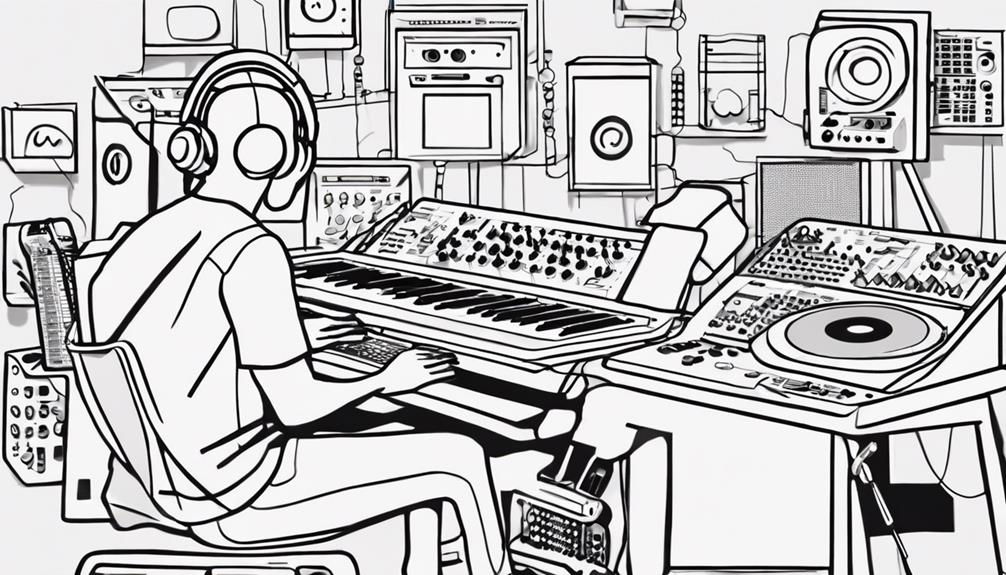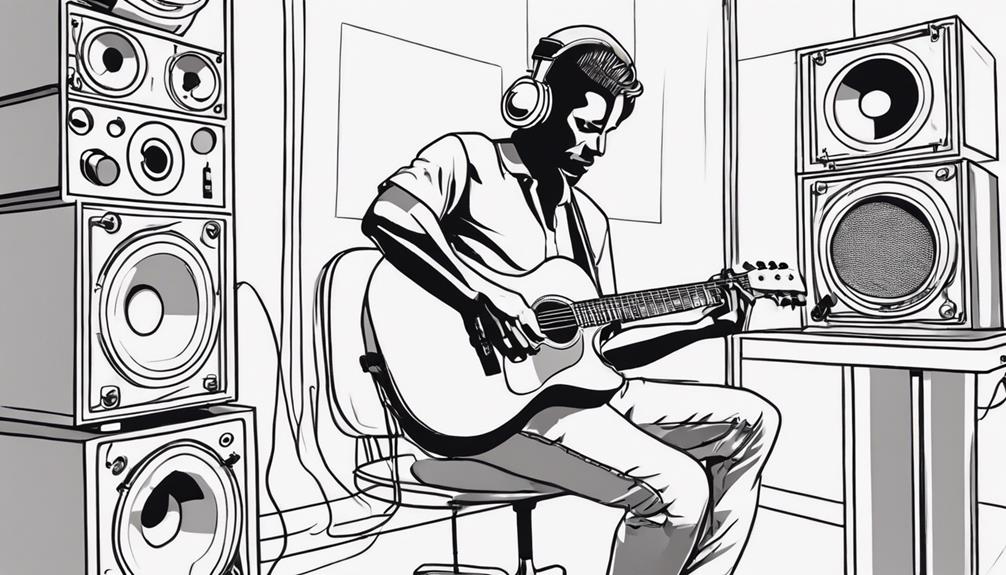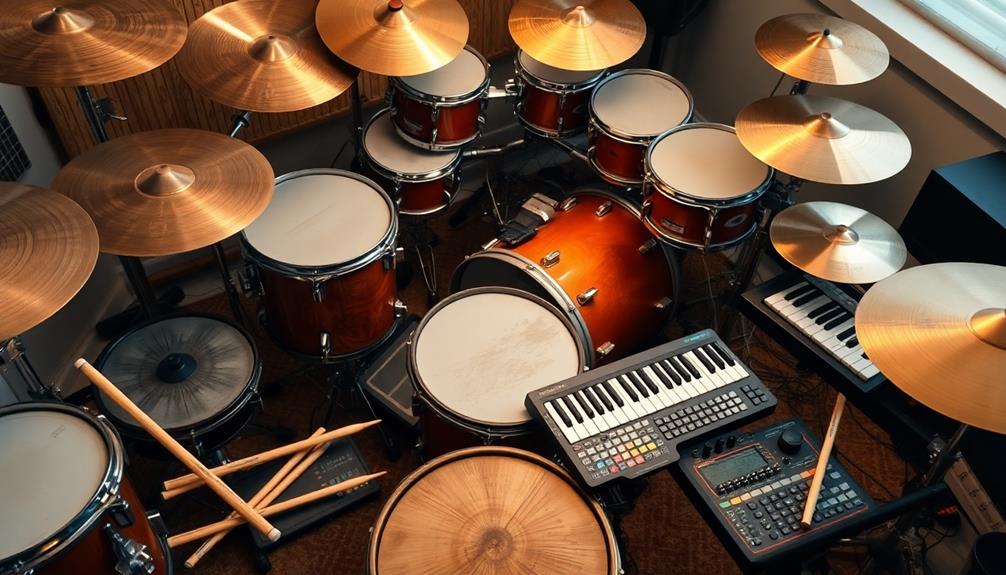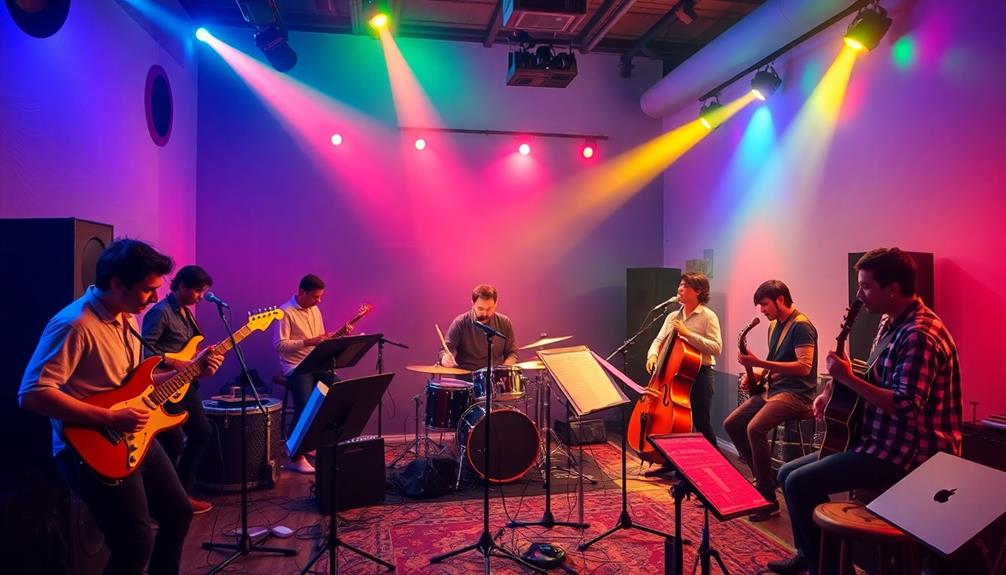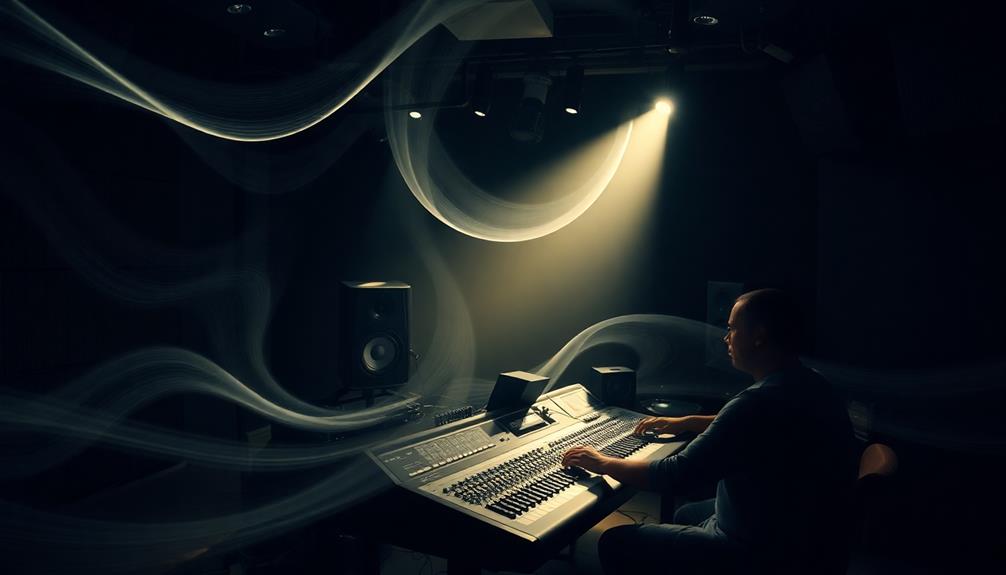Start by setting up a home studio with DAW software and quality equipment. Learn music production techniques like beat-making and mixing. Collaborate with diverse musicians to spark creativity. Experiment with virtual instruments for unique sounds. Master mixing and mastering for professional quality. Promote your music on social media and streaming services. There are more tips to enhance your music production journey.
Key Takeaways
- Set up a home studio with essential equipment.
- Learn music production techniques through practice and education.
- Collaborate with other musicians for creative inspiration.
- Experiment with virtual instruments and sounds for unique creations.
- Explore mixing, mastering, and promotion strategies for your music.
Setting Up Your Home Studio
When establishing your home studio, make sure you have all the essential equipment for a productive music production environment. Your studio should include a computer with DAW software, an audio interface for connecting instruments and microphones, microphones for capturing sound, and studio monitors for accurate playback.
Consider adding acoustic treatment like acoustic panels and bass traps to improve the sound quality in your recording space. Proper cable management is vital to avoid clutter and signal interference, so organize your cables neatly.
Ensure your microphone setup and monitoring system are correctly configured to capture and monitor audio accurately during recording and production. Creating a comfortable and inspiring workspace within your studio is essential for enhancing creativity and productivity in your music production process.
Make sure your workspace is organized and free from distractions to help you focus on your music. By setting up your home studio with these elements in place, you'll be ready to start creating your own music productions effectively. Additionally, invest in quality equipment and arrange it ergonomically to ensure comfort and efficiency during sessions. Consider soundproofing and optimizing the acoustics of your space, as these factors can significantly impact the clarity and quality of your recordings. Learning how to set up for music production properly can make all the difference in achieving professional results and staying inspired.
Learning Music Production Techniques

You'll explore key production concepts that are essential for creating music that stands out.
Get ready for hands-on practice opportunities that will allow you to hone your skills and unlock your creativity.
These techniques will help you craft dynamic and professional-sounding music productions.
Key Production Concepts
Understanding key production concepts in music production involves mastering various techniques like beat-making, melody composition, mixing, audio editing, arrangement, and mastering to create professional and engaging tracks.
Immerse yourself in these essential elements:
- Beat-Making Techniques: Start by mastering drum programming to create captivating rhythms that form the foundation of your music.
- Melody Composition: Explore chord progressions and harmony to craft memorable and catchy melodies that resonate with your listeners.
- Mixing Techniques: Experiment with EQ, compression, and effects to balance and enhance each element of your song, ensuring clarity and cohesion.
- Audio Editing and Arrangement: Learn how to structure your compositions effectively through editing and arranging, keeping the audience hooked from start to finish.
Hands-On Practice Opportunities
Engage in practical exercises to develop your music production skills through hands-on practice opportunities.
Utilize a digital audio workstation (DAW) like Ableton Live or Logic Pro to familiarize yourself with music production tools. Experiment with arranging loops, adding effects, and mixing tracks to grasp the basics of music production techniques.
Immerse yourself in recording techniques such as layering instruments and incorporating samples to enhance your skills further. Collaborating with musicians or producers can provide valuable hands-on experience and expose you to new music production techniques.
Attend workshops, online tutorials, or courses to deepen your understanding of music production and refine your abilities.
Collaborating With Other Musicians
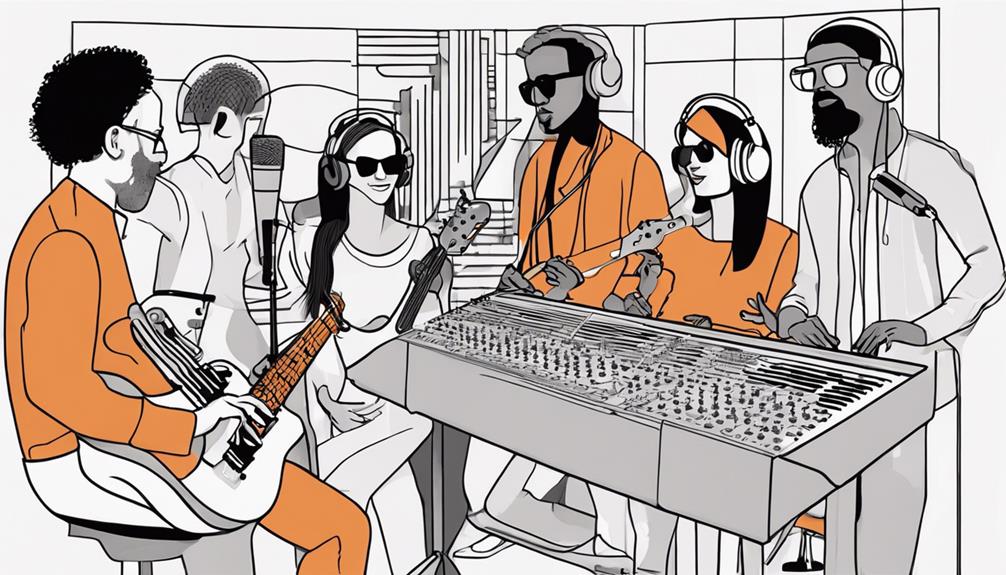
In addition, collaborating with other musicians can greatly enhance the creative process and elevate the quality of your music production.
When working with musicians from diverse backgrounds, you open the door to fresh ideas and different perspectives. This mix of influences can lead to new creative directions and innovative techniques.
Moreover, collaborating provides valuable networking opportunities, allowing you to connect with a broader audience and learn from others in the music industry.
Experimenting With Sounds and Virtual Instruments
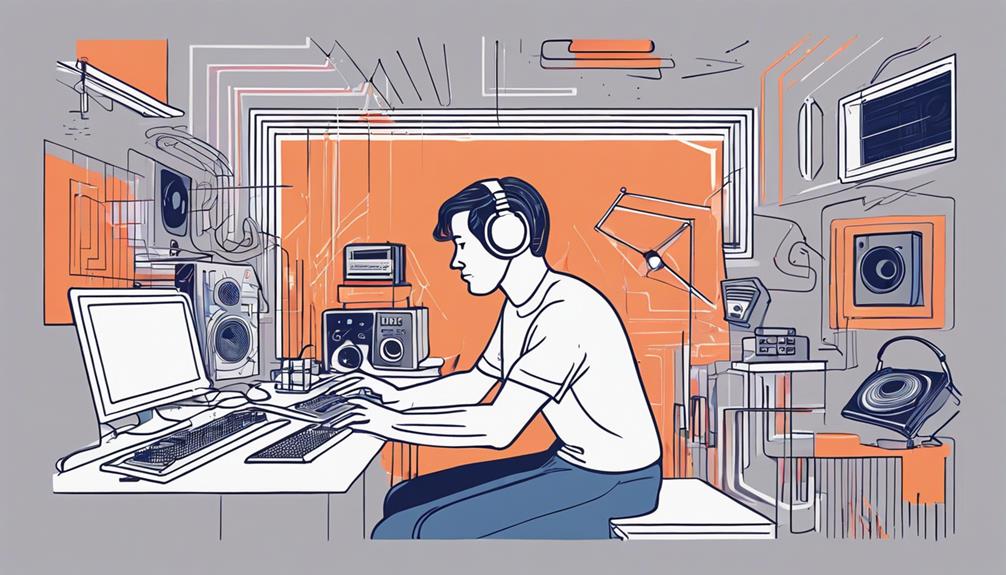
To expand your music production skills, consider exploring the world of virtual instruments and experimenting with various sounds to enhance your creative projects. Virtual instruments offer a vast array of audio possibilities, from synthesizers to guitars, allowing you to experiment with different textures and tones.
By incorporating virtual instruments into your DAW, you can easily access a wide range of sounds to elevate your music production.
Experimenting with virtual instrument plugins can spark your creativity and inspire new musical ideas. These plugins often come with presets that serve as a great starting point, which you can then customize to suit your unique style and vision.
Whether you're looking for electronic beats from a drum machine or the rich melodies of an orchestral instrument, virtual instruments provide the tools you need to bring your music to life.
Exploring Mixing and Mastering
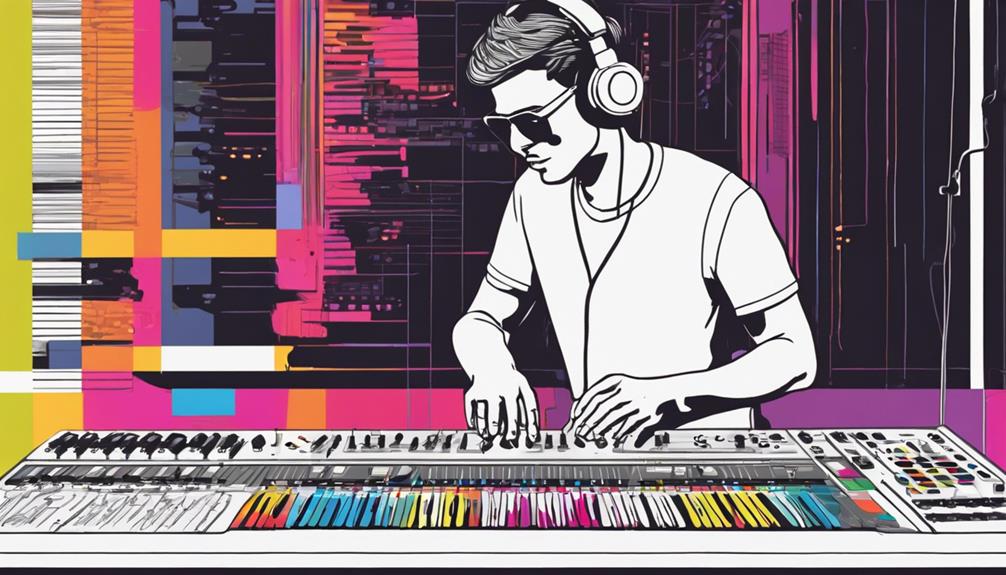
Now it's time to learn about mixing and mastering.
You'll discover how adjusting individual tracks and enhancing overall sound quality can transform your music.
Understanding these basics is key to achieving professional-sounding tracks.
Mixing Basics
Explore the fundamentals of mixing in music production to craft a professional and cohesive sound for your tracks.
When diving into mixing basics, remember these key points:
- Balancing Tracks: Start by adjusting the volume levels of each track to guarantee they all blend harmoniously.
- Applying Effects: Utilize EQ to sculpt the frequency content, compression to control dynamics, reverb for spatial depth, delay for echoes, and panning to position sounds in the stereo field.
- Creating Cohesive Sound: Aim to make all elements of your mix work together seamlessly, enhancing the overall listening experience.
- Utilizing Techniques: Experiment with EQ to carve out space for different instruments, use compression to control peaks, add reverb and delay for depth and dimension, and employ panning to widen the sound stage.
Mastering Techniques
Adjusting the levels, EQ, dynamics, and spatial effects of your mix in mastering is essential for achieving a polished and professional sound. Mastering serves as the final step in the music production process, focusing on enhancing sound quality and ensuring consistency across tracks.
By balancing frequencies and controlling dynamics, mastering helps optimize audio for different playback systems and formats, ensuring your music sounds great on various devices. Utilizing specialized tools and techniques, professional mastering engineers work to maximize the overall loudness of the music while providing a cohesive and balanced listening experience for the audience.
The goal of mastering is to make your music sound its best across different platforms and environments, delivering a top-tier, professional sound that captivates listeners. So, when mastering your tracks, remember to pay attention to details like EQ, dynamics, and spatial effects to achieve that polished and cohesive final product.
Audio Quality Optimization
Enhancing the audio quality of your music production involves a careful balance between mixing and mastering techniques. To optimize your tracks for a professional-sounding result, consider the following:
- Mixing: Adjust individual tracks by fine-tuning volume levels, panning, and utilizing EQ to create a balanced sound that allows each element to shine.
- Mastering: Focus on enhancing the overall audio quality by applying effects and techniques to polish the final mix, preparing it for distribution and ensuring it sounds great across various playback systems.
- Utilize Audio Plugins: Incorporate audio plugins to add depth, clarity, and character to your tracks, enhancing the overall quality of your production.
- Achieve Balance: Strike a balance between the mixing and mastering processes to maintain the integrity of your music while elevating it to a professional standard.
Understanding these key differences and utilizing the right tools will help you create tracks that sound polished and ready for the world to hear.
Promoting Your Music for Distribution
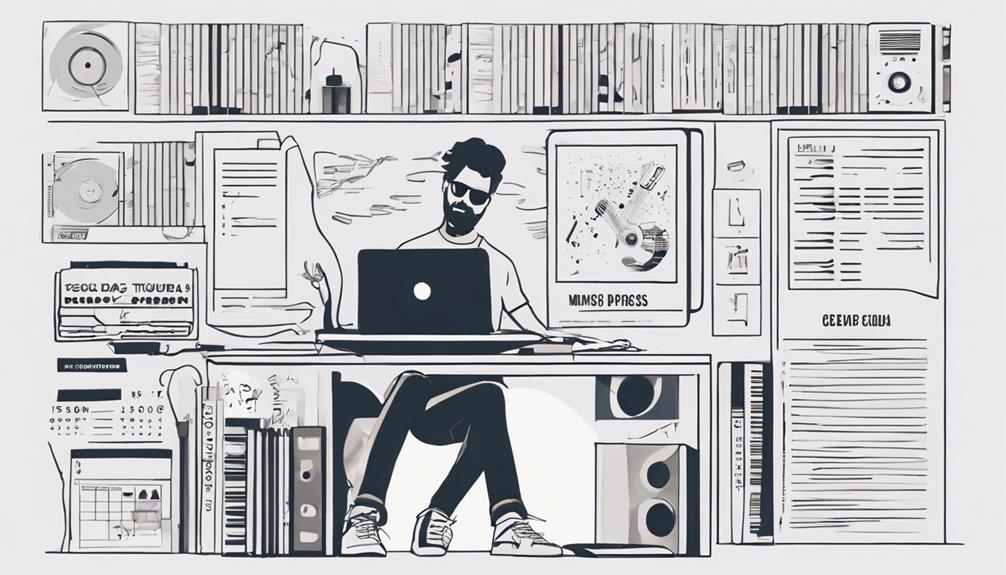
To effectively promote your music for distribution, leverage social media platforms such as Instagram, Facebook, and Twitter to reach a broader audience. These platforms allow you to engage with fans, share updates about your music, and create a buzz around your releases.
In addition to social media, consider creating a professional website or utilizing platforms like SoundCloud, Bandcamp, or YouTube for music distribution. Collaborating with music influencers, bloggers, and online magazines can also help in promoting your music to a wider audience.
Utilizing streaming services like Spotify, Apple Music, and Amazon Music is essential to reaching a global audience and increasing your music's visibility. Moreover, engaging with your fans through live streams, virtual concerts, and interactive content can help build a loyal fan base and generate excitement around your music.
Frequently Asked Questions
How Do I Start My Own Music Production?
Start your music production journey by learning basic techniques, acquiring essential equipment and software, and practicing regularly. Collaborate with fellow musicians, connect with industry professionals, and build your online presence to kickstart your career.
Where Do I Start as a Music Producer?
Start as a music producer by choosing a digital audio workstation. Invest in essential equipment for quality recordings. Learn basic production techniques like recording and mixing. Experiment with genres and collaborate with others to expand your skills.
How to Produce a Song With No Experience?
Begin your journey into music production with no experience by choosing a beginner-friendly DAW. Immerse yourself in tutorials and online guides to understand recording basics. Experiment with loops and virtual instruments to create your first song.
How Do I Come up With Music Production Ideas?
To come up with music production ideas, listen to diverse genres, collaborate with others, draw from personal experiences, keep notes, and analyze song structures. This process sparks creativity and helps craft unique and innovative productions.
Conclusion
Now that you've set up your home studio, learned music production techniques, collaborated with other musicians, experimented with sounds, and explored mixing and mastering, it's time to promote your music for distribution.
By taking the steps to create your own music production, you aren't only following your passion but also setting yourself up for success in the industry. By investing time and effort to create your own music production, you are honing your skills and developing a unique sound that resonates with your audience. This not only helps you stand out in a competitive market but also builds your confidence as an artist. Remember, every great producer starts somewhere, and staying dedicated to your craft will open doors to countless opportunities.
Keep creating, keep evolving, and watch as your music reaches new heights of recognition and appreciation.

